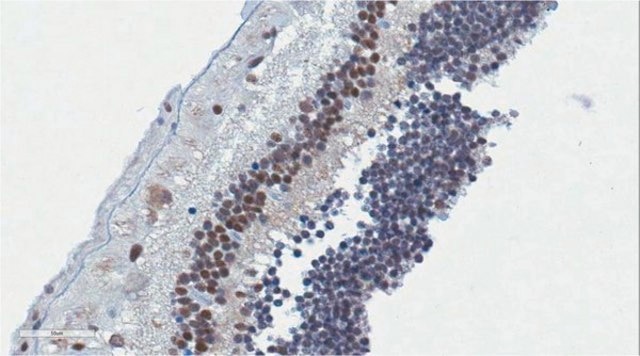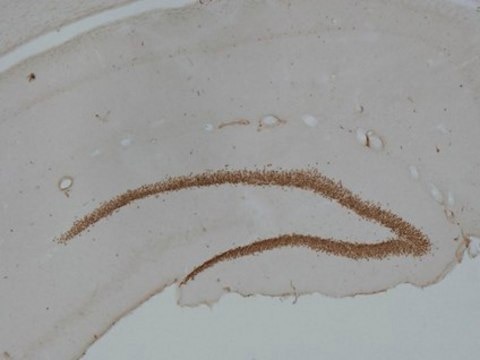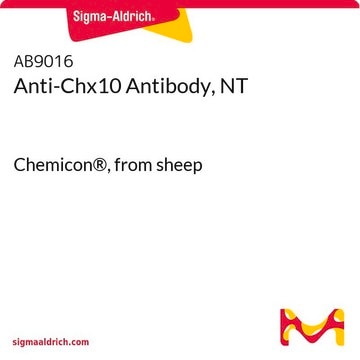AB5475
Anti-Prox 1 Antibody
serum, Chemicon®
Synonym(s):
Anti-A230003G05Rik, Anti-PROX-1
Sign Into View Organizational & Contract Pricing
All Photos(5)
About This Item
UNSPSC Code:
12352203
eCl@ss:
32160702
NACRES:
NA.41
Recommended Products
biological source
rabbit
Quality Level
antibody form
serum
antibody product type
primary antibodies
clone
polyclonal
species reactivity
rat, mouse, zebrafish
species reactivity (predicted by homology)
human
manufacturer/tradename
Chemicon®
technique(s)
immunocytochemistry: suitable
immunohistochemistry: suitable
NCBI accession no.
UniProt accession no.
shipped in
dry ice
target post-translational modification
unmodified
Gene Information
human ... PROX1(5629)
General description
Prox1, the homolog of Drosophila Prospero, is a homeobox-containing transcription factor that binds and functions as a co-receptor of liver receptor homolog 1 (LRH1/NR5A2). It is a specific marker for lymphatic endothelial cells, as well as hepatoblasts and hepatocytes. Human Prox1 shares 97% amino acid sequence identity with mouse and rat Prox1.
Specificity
Other species have not been tested.
Recognizes Prox1. The antibody is useful for identifying Prox1 expressing cells during the development of many areas of the nervous system including the dorsal spinal cord, ganglionic eminences, thalamus and hippocampus.
Immunogen
Synthetic peptide from the C-terminus of mouse Prox1.
Application
Detect Prox 1 using this Anti-Prox 1 Antibody validated for use in IC, IH.
Immunohistochemistry:
1:2,000-1:10,000 with overnight incubation on 4% paraformaldehyde fixed, frozen tissue sections. For embryos immersion fixation is recommended. For older animals perfusion fixation is recommended. Suggested permeabilization solution is 0.1% Triton X100. Suggested blocking buffer is PBS with 0.1% Triton and 10% serum.
Immunocytochemistry:
A previous lot of this antibody was used on Immunocytochemistry
1:2,000-1:10,000 with overnight incubation on 4% paraformaldehyde fixed, frozen tissue sections. For embryos immersion fixation is recommended. For older animals perfusion fixation is recommended. Suggested permeabilization solution is 0.1% Triton X100. Suggested blocking buffer is PBS with 0.1% Triton and 10% serum.
Immunocytochemistry:
A previous lot of this antibody was used on Immunocytochemistry
Physical form
Rabbit serum in 50 % glycerol.
Storage and Stability
Stable for 1 year at -20°C from date of receipt. Note: Variability in freezer temperatures below -20°C may cause glycerol containing solutions to become frozen during storage.
Analysis Note
Control
Embryonic brain tissue.
Embryonic brain tissue.
Other Notes
Concentration: Please refer to the Certificate of Analysis for the lot-specific concentration.
Legal Information
CHEMICON is a registered trademark of Merck KGaA, Darmstadt, Germany
Not finding the right product?
Try our Product Selector Tool.
recommended
Product No.
Description
Pricing
wgk_germany
WGK 1
Certificates of Analysis (COA)
Search for Certificates of Analysis (COA) by entering the products Lot/Batch Number. Lot and Batch Numbers can be found on a product’s label following the words ‘Lot’ or ‘Batch’.
Already Own This Product?
Find documentation for the products that you have recently purchased in the Document Library.
Lysophosphatidic acid up-regulates vascular endothelial growth factor-C and lymphatic marker expressions in human endothelial cells.
C-I Lin,C-N Chen,M-T Huang,S-J Lee,C-H Lin,C-C Chang,H Lee
Cellular and Molecular Life Sciences null
Long-range axonal calcium sweep induces axon retraction.
Yamada, RX; Sasaki, T; Ichikawa, J; Koyama, R; Matsuki, N; Ikegaya, Y
The Journal of Neuroscience null
The ubiquitin proteasome system is required for cell proliferation of the lens epithelium and for differentiation of lens fiber cells in zebrafish.
Imai, F; Yoshizawa, A; Fujimori-Tonou, N; Kawakami, K; Masai, I
Development null
Granule cells in the CA3 area.
Szabadics, J; Varga, C; Brunner, J; Chen, K; Soltesz, I
The Journal of Neuroscience null
Nathan C Bird et al.
Methods in molecular biology (Clifton, N.J.), 798, 153-169 (2011-12-02)
During myogenesis, cells gradually transition from mesodermal precursors to myoblasts, myocytes, and then to muscle fibers. The molecular characterization of this process requires the ability to identify each of these cell types and the factors that regulate the transitions between
Our team of scientists has experience in all areas of research including Life Science, Material Science, Chemical Synthesis, Chromatography, Analytical and many others.
Contact Technical Service






